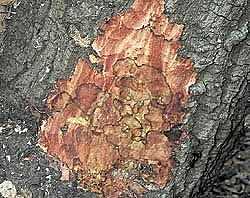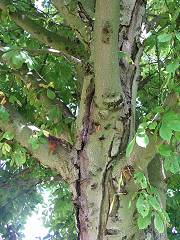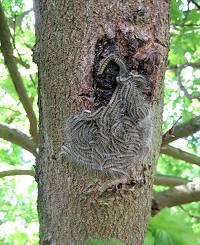Chalara fraxinea fungus
Chalara dieback of ash is a serious disease of ash trees
caused by a fungus called Chalara fraxinea
Symptoms include leaf loss and crown dieback and can result in
the death of the tree. The Forestry Commission is working with
scientists from the Food and Environment Research Agency (FERA),
and woodland managers and landowners are urged to check the health
of their trees. It is thought that the disease arrived in Britain
from imported plants from the Netherlands for the nursery
trade.
If you suspect a tree has this fungus then
please contact the Forestry
Commission.
Other known threats to our trees include:

Phytophthora ramorum
A fungal pathogen that infects the
commercially important conifer species, Japanese larch, also beech
and oak trees (sudden oak death). Symptoms are bleeding lesions on
trunk and limbs.

Great spruce bark beetle
This beetle (which was accidentally
introduced from continental Europe) breeds under the
bark, weakening the infected tree and in extreme cases, can kill
the tree.

Horse chestnut bleeding canker
The canker appears as an area of dying bark that oozes liquid.
If it spreads around the entire trunk, it cuts off the food supply,
killing the tree

Oak processionary moth (Thaumetopoea processionea)
The oak processionary moth is a major
defoliator of oak in Europe. The larvae (caterpillars) feed on the
foliage of many species of oaks, including English, Sessile and
Turkey oaks (Quercus robur, Q.petraea and Q.cerris).
Hornbeam, hazel, beech, sweet chestnut
and birch are also reported to be attacked, although mainly when
growing next to severely defoliated oaks. Oak processionary moth is
also a risk to human health. The larvae (caterpillars) are covered
in irritating hairs that contain a toxin and contact with these
hairs, or their inhalation, can result in skin irritation and
allergic reactions. These problems are significant because oak
processionary is often most abundant on urban trees, along forest
edges and in amenity woodlands.